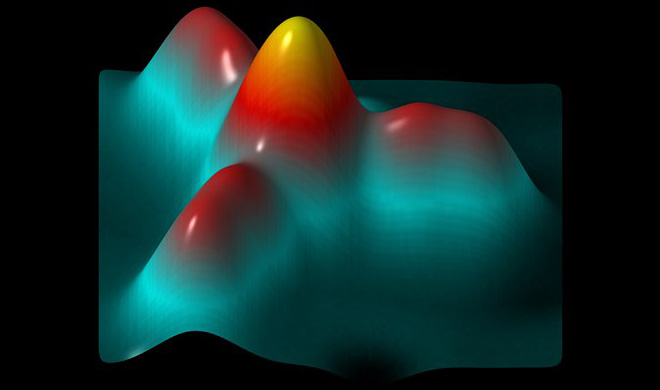Press release
With the right symmetry to more stable data bits
A team from the Universität Hamburg in cooperation with Forschungszentrum Jülich and the Dutch University of Leiden has succeeded in magnetically coupling a particle of three iron atoms with other iron atoms in a controlled manner. If these are docked with the correct symmetry, they could serve as data bits for future memory elements. The scientists report their results in the current issue of Nature Communications.
Spintronics offers a promising approach for reducing the energy consumption of current computer processors. This technology does not use the charge of electrons for data processing, but their magnetic orientation, the so-called spin.
One problem, however, is the stability of the magnetic orientation of these spins when they are used as data bits. In the laboratory, at a temperature close to absolute zero around minus 273 degrees Celsius, it remains relatively stable. However, if the temperature is increased slightly, the spins become unstable.
In order to find solutions to this problem, the Hamburg physicists first constructed a magnetic data bit from three iron atoms, which they assembled on a platinum surface using a spin-polarized scanning tunneling microscope.
After more atoms were added, the whole structure was surprisingly less magnetically stable. "We had assumed that the addition of atoms makes a data bit fundamentally more stable," says Dr. Jens Wiebe, who heads the project in Prof. Roland Wiesendanger's research group at the Department of Physics at Universität Hamburg. "Surprisingly, this was not the case here. We continued to experiment and found that only with a very symmetrical spatial arrangement of the additional iron atoms around the triatomic iron particle did the data bit become magnetically stable again and an unusually long extension of the lifetime of the spin states occurred (see figure). Symmetry seems to have a much greater influence on magnetic stability than previously assumed."
Such magnetically stable arrangements of atoms on a surface would be promising candidates for building blocks in spintronics and for future quantum computers.

Here, the triatomic iron particle (hill in the middle) can be seen on the platinum surface, to which two iron atoms are magnetically coupled symmetrically on three sides (the three arms).
Image: UHH/MIN/Wiebe
Original publication:
Stabilizing spin systems via symmetrically tailored RKKY interactions,
J. Hermenau, S. Brinker, M. Marciani, M. Steinbrecher, M. dos Santos Dias, R. Wiesendanger,
S. Lounis, and J. Wiebe,
Nature Communications 10, 2565 (2019).
DOI: 10.1038/s41467-019-10516-2
Weitere Informationen:
Prof. Dr. Prof. h.c. Dr. h.c. Roland Wiesendanger
Department of Physics
Universität Hamburg
Jungiusstr. 11a
20355 Hamburg
Phone: (0 40) / 42838 - 52 44
E-mail: wiesendanger@physnet.uni-hamburg.de
